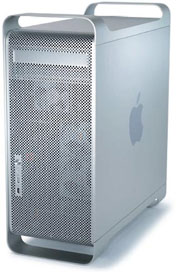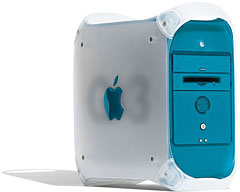I’ve been using Classic Mode on G4 Power Macs for years, but now I have a 2.3 GHz Power Mac G5 with dual processors. It can’t boot Mac OS 9 natively, but it can run Classic Mode. How fast is it?
 One beautiful thing about dual-processor Macs is that they can fully dedicate one CPU to Classic Mode. If you run Classic on a single processor machine,there can be times when it can tie up the entire machine, something I used to run into when uplading site changes using Claris Home Page.
One beautiful thing about dual-processor Macs is that they can fully dedicate one CPU to Classic Mode. If you run Classic on a single processor machine,there can be times when it can tie up the entire machine, something I used to run into when uplading site changes using Claris Home Page.
Time to pull out the old benchmark tests!
Speedometer 3
The base machine for Speedometer 3 is a Mac Classic with 2 MB of memory, the original 40 MB hard drive, and System 6.0.7, which rates 1.0 on the basic tests. (KWhetstones and Dhrystones are absolute numbers.) This predates PowerPC Macs, so the code is native 68k only.
- CPU: 876.00
- Graphics: 121.48
- Disk: 1517.00
- Math: 2054.24
- Overall: 895.67
- KWhetstones: 30,000/sec
- Dhrystones: 600,000/sec
My fastest points of comparison are a 266 MHz Beige Power Mac G3, which scores 134.8 on the CPU test and 637.9 on math, and a 233 MHz iMac Revision B, which achieves a 69.1 score in graphics and 13.3 on the disk test. These are obviously a far cry from what a dual processor system running at roughly 10x the clock speed can provide.
Speedometer 4
For Speedometer 4, the base machine appears to be a Quadra 700 or Centris 650, both 25 MHz 68040 Macs that nominally rate 1.0 on most tests. Speedometer 4 supports both 68k and PowerPC Macs natively.
- CPU: 81.02
- Graphics: n/a
- Disk: 5.038
- Math: 39087.5
- KWhetstones: 803,213/sec
- Dhrystones: 2,147,483/sec.
The last (and fastest) Mac I tested using Speedometer 4 was a Digital Audio Power Mac G4 upgraded with a G4 running at 1.53 GHz. It’s CPU score was 93.4-93.7 depending on OS, easily outperforming the Dual G5. Its disk score or 4.8-4.9 nearly ties the G5, but it’s math score is just 10% of what the G5 provides.
My long-gone 400 MHz PowerBook G4 running Mac OS 9.2.2 natively scored 30.6 on the CPU test, 3.35 on the disk test, and 1124.6 on the math test. Such a low clock speed, yet the CPU scores almost 38% as fast as a 2.3 GHz G5 – that’s shocking and perhaps indicates an issue with the benchmark test itself.
MacBench 5
 In MacBench 5, the reference system is a 300 MHz Blue & White Power Mac G3, which scores 1000.
In MacBench 5, the reference system is a 300 MHz Blue & White Power Mac G3, which scores 1000.
- Processor: 5015
- Floating Point: 6095
- Disk: 12118
For comparison, my 400 MHz PowerBook G4 running Mac OS 9.2.2 natively scored 1282 on the Processor test, 1519 on Floating Point, and 457-2237 depending on hard drive and cache size in the Disk test.
I ran MacBench 5 on that 1.53 GHz upgraded Digital Audio Power Mac G4. When natively running Mac OS 9.2.2, it scored 3714 on CPU, 3773 on math, and 3508 on disk, all of which the Power Mac G5 handily beat.
SpeedRun PPC
I have lots of more up-to-date results for SpeedRun PPC, which was written specifically for PowerPC Macs in the Classic Mac OS era. All supplied results are for machines booting Mac OS 9.2 natively. I had to set graphics to thousands of colors; the other benchmarks were all run in standard millions of colors mode.
Here’s how the Dual 2.3 GHz G5 scores:
- Graphics: 1156
- Harddrive: 1481
- Processor: 803
- RAM: 4444
- Overall: 1971
If you think that sounds impressive, it does, but there is one instance where an older, slower G4 Power Mac outperform it. On the Graphics test, a 1.0 GHz Dual Quicksilver 2002 hits 1273. The 867 MHz Quicksilver comes close on the Harddrive test, scoring 1365 – not too far behind my Dual G5.
The Power Mac G5 wins handily on overall performance, with a score of 1971. That dual G4 reaches nearly 75% of that performance at 1416, indicating that a dual 2.3 GHz G5 system is nowhere near as much faster than a dual 1.0 GHz G4 Mac than processor speed would lead you to expect.
Conclusion
This 2.3 GHz Power Mac G5 with dual processors is a very nice machine, and the fact that it runs Classic Mode is wonderful. It’s no speed demon by today’s standards. Even the earliest Core Duo Macs introduced in 2006 have more power. But they can’t run Classic Mode, and this is one of the fastest Macs than can (the dual 2.5 GHz, dual 2.7 GHz, dual-core 2.3 GHz, and quad-core 2.5 GHz G5 Power Macs are the only faster PowerPC Macs).
No, the G5 is not a much superior to the G4 as clock speed would predict, but overall it does provide superior performance to the other Macs I’ve tested using Classic Mode. I suspect a 1.25 GHz dual-processor Mirrored Drive Door might give it a run for its money, and it’s possible the 1.42 GHz FireWire 800 model could outperform this G5 overall, but those tend to still command a pretty premium price.
If you need good Classic Mode performance, check your local Craigslist. You may well find a bargain like mine for under $100 – sometimes half that. And you do want to buy locally; these big, heavy beasties cost quite a bit to ship.
Keywords: #classicmode #powermacg5
Short link: http://goo.gl/loDncP
searchword: classicong5


I can confirm everything from your word .
People can check this video for understand MacMini I5 2.3 ghz Vs PowerMac G5 2.5 Quad
The funny thing is that the classic Mac OS uses a lot of very old code for the Motorola MC680x0-processor family. These processors had been in use on the original Macintosh and models up to about 1994. When the PPC was introduced most of the code had to be emulated on the new Macs, making many tasks definitely slower than on their Quadra (MC68040-powered) predecessors.
My favourite calculator was a “desk accessory” (small program accessed by the Apple menu, kind of pre-System 1-multitasking) from Borland’s “Sidekick” suite (which was more popular in the PC-wold) copyrighted in 1985. It runs very fine in Classic mode (and is much less buggy than its Mac OS X counterpart was for years), but is actually MC68000-code run by an emulator, itself running as part of an operating system that runs on a virtual machine (Classic mode) on a G5 PowerMac that is 20 years younger than the software!
If you will be using SheepShaver emulator software on next year’s Macs, you’ll be able to bridge another ten years, running 1985 software on 2015 hardware.
Daniel, that is very cool when you think about it like that. The fact is, we have so much processing power available to us these days, that we should be able to emulate any different OS/CPU platform from 20 to 30 years ago. There’s the whole history of personal computing available to someone who wants to set up all the virtual machines on their newer hardware.